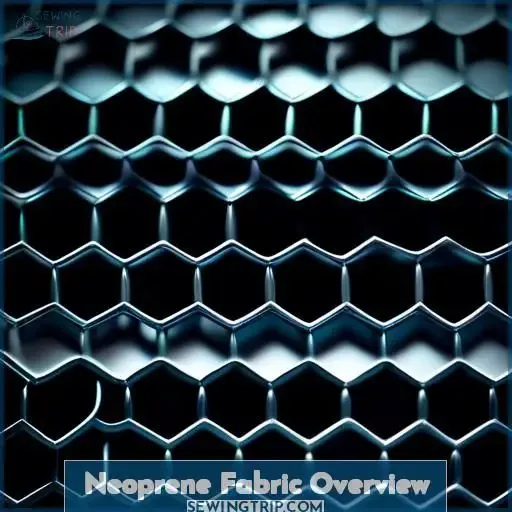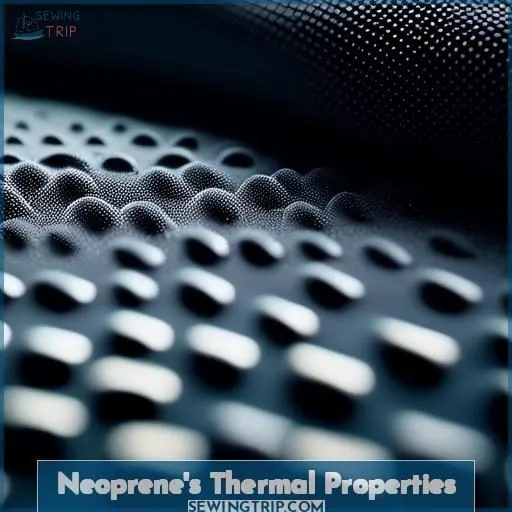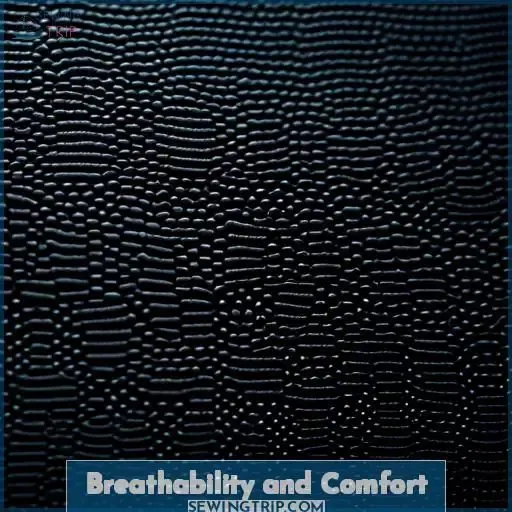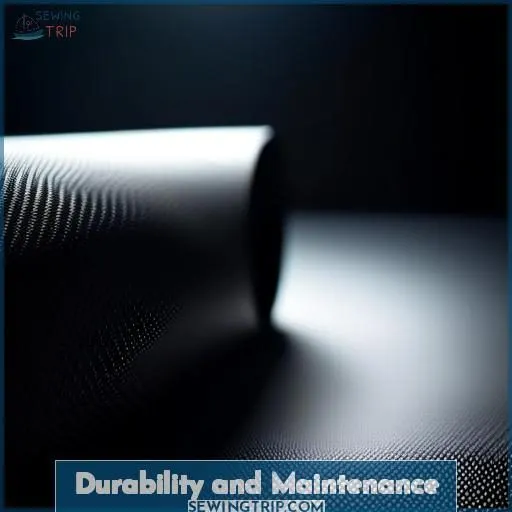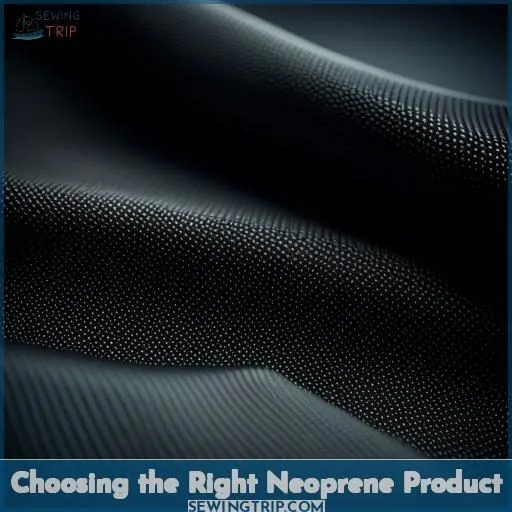This site is supported by our readers. We may earn a commission, at no cost to you, if you purchase through links.
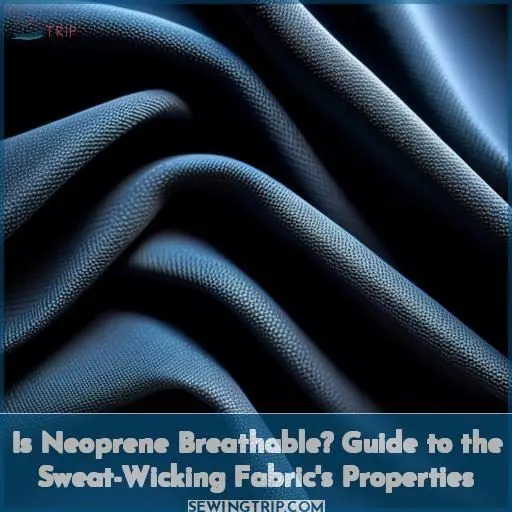
Yes, neoprene is highly breathable and effectively wicks away sweat.
Its closed-cell structure allows perspiration to evaporate, keeping you drier and more comfortable than materials like leather.
Neoprene’s superior breathability makes it ideal for sportswear and activewear, dissipating heat and moisture to prevent overheating.
Whether you’re surfing, diving, or hitting the gym, neoprene’s sweat-wicking capabilities help you maintain your coolness and concentrate on your performance.
But the benefits don’t end there – neoprene offers exceptional durability and versatility across various applications.
Table Of Contents
Key Takeaways
- Neoprene is a highly breathable and sweat-wicking synthetic rubber material.
- Its closed-cell structure allows perspiration to evaporate, keeping you drier and more comfortable than materials like leather.
- Neoprene’s superior breathability makes it ideal for sportswear and activewear, dissipating heat and moisture to prevent overheating.
- Neoprene’s versatility extends beyond seat covers, with applications in wetsuits, industrial equipment, and more.
Neoprene Fabric Overview
Neoprene is a synthetic rubber material composed of chloroprene and other compounds, first developed in the 1930s as an oil-resistant substitute for natural rubber. Its unique chemical structure and manufacturing process give neoprene its distinctive properties, including flexibility, insulation, and resistance to various elements.
Definition and Composition
Neoprene is a synthetic rubber made by the polymerization of chloroprene, a chemical compound that provides superior resistance to oils and is used for special-purpose clothing and gear. It’s a versatile and efficient material, especially for outerwear and sportswear. Neoprene is known for its elasticity, durability, and waterproof properties, which make it ideal for extreme environments and temperature regulation.
Historical Development
Neoprene’s Historical Development
Neoprene, the synthetic rubber developed by the DuPont Company in 1930-1931, has a rich history that spans over a century. Its creation was a result of the increasing demand for a synthetic alternative to natural rubber, which was becoming increasingly expensive and scarce. The roots of neoprene can be traced back to the 1920s, when Julius Arthur Nieuwland, a professor of chemistry at the University of Notre Dame, discovered divinyl acetylene, a jelly that could be transformed into an elastic compound.
In 1928, a Harvard University instructor named Wallace Carothers took over the project and led the team to develop a material that was resistant to both chemicals and light, two variables that were detrimental to earlier iterations. The material was formally launched under the name DuPrene at the Rubber Division of the American Chemical Society in 1931.
However, DuPont didn’t produce any products containing DuPrene at the time. Instead, they sold the material to manufacturers of end products. In 1937, the material was given its more generic name, neoprene, to signify that it was an ingredient, not a finished consumer product. By 1939, sales of neoprene were generating over $300,000.
Neoprene’s development was a significant breakthrough in the field of synthetic rubbers, and it has since been used in a wide range of applications, from industrial parts to everyday products like wetsuits and gaskets. Its unique properties, such as high resistance to oil, flames, and ozone, have made it a popular choice for heavy-duty applications in various industries.
| Year | Event |
|---|---|
| 1923 | Father Julius Arthur Nieuwland discovers acetylene gas polymerization |
| 1928 | Wallace Carothers takes over the project |
| 1930 | DuPont begins the manufacture of DuPrene |
| 1931 | DuPrene is launched at the Rubber Division of the American Chemical Society |
| 1937 | Neoprene is given its more generic name |
| 1939 | Sales of neoprene generate over $300,000 |
Neoprene’s historical development is a proof of its versatility and usefulness in various industries. From its humble beginnings as a synthetic rubber to its current status as a widely used material in numerous applications, neoprene has truly revolutionized the way we manufacture and use products.
Neoprene’s Thermal Properties
Neoprene’s excellent insulation properties make it an ideal choice for activities in cold weather. Its closed-cell structure traps heat, keeping you warm and protected from the elements, while its thickness regulates temperature, preventing overheating in warmer conditions.
Heat Retention Capabilities
Neoprene, a synthetic rubber, is renowned for its exceptional heat retention capabilities.
With its insulating properties, it helps preserve a comfortable temperature, making it an ideal choice for applications where warmth is crucial.
For instance, Orvis waders crafted from neoprene offer warmth in frigid water, keeping you comfortable during fishing excursions.
Doc Holiday, a neoprene seat cover, guarantees your rear end remains warm during the winter.
By effectively managing moisture, neoprene inhibits sweating and maintains dryness, making it a popular choice for those seeking moisture-wicking fabrics.
Cold Resistance
Cold weather is a common concern for people who live in areas with harsh winters or for those who enjoy outdoor activities in cold environments. Neoprene, a synthetic rubber material, is often used for its insulating properties in waders and other cold-weather gear. Here are three key points about neoprene’s cold resistance:
- Insulation: Neoprene is known for its ability to trap heat and provide insulation, making it an ideal material for cold-weather gear. It can help keep you warm in freezing temperatures, even when submerged in water.
- Water resistance: Neoprene is highly resistant to water penetration, guaranteeing that you stay dry even in cold, wet conditions.
- Wind protection: Neoprene waders can also protect against wind, providing an extra layer of warmth in cold environments.
When choosing waders for cold weather, consider the following factors:
- Thickness: Neoprene waders come in various thicknesses, with thicker options providing better insulation for extremely cold conditions.
- Seam construction: Look for waders with sealed seams or multi-layer sealing to prevent water leakage and guarantee maximum durability and water resistance.
- Insulation options: Some models offer removable liners or additional layers that provide extra warmth during colder months.
Neoprene waders are suitable for fishing in cold water and can be used in a variety of environments, including ice fishing, canoe trips, and back country adventures. However, they may not be as breathable as other materials, so consider this when planning your activities in warmer weather.
Breathability and Comfort
Neoprene’s breathability and moisture-wicking capabilities are far superior to leather, keeping you drier and more comfortable. Unlike leather, neoprene’s closed-cell structure allows perspiration to evaporate while preventing liquid transfer, so your backside won’t get soaked with sweat.
Comparison With Leather
Regarding the adornment of your automobile’s seats, the contrast in breathability between neoprene and leather is stark. Neoprene excels in temperature control, ensuring your comfort during sweltering summers and cozy warmth during the frigid winter months. Here’s a concise overview of their key differences:
| Feature | Neoprene | Leather |
|---|---|---|
| Breathability | High | Low |
| Comfort Level | Sublime | More firm |
| Price Differences | Economical | More expensive with a touch of elegance |
Sweat Management
Neoprene’s breathability is a key factor in managing sweat and maintaining comfort.
Unlike leather, neoprene is known for its moisture-wicking properties, which help absorb sweat and dissipate heat.
This means that neoprene seat covers can keep you cooler and more comfortable in hot weather.
They won’t make you sweat as much as leather seats.
Additionally, neoprene is more breathable than leather, allowing for better heat dissipation and a higher level of comfort.
Durability and Maintenance
Regarding durability, neoprene exhibits exceptional resistance to abrasion and tearing, guaranteeing the longevity of your seat covers for years to come. In terms of upkeep, neoprene is remarkably easy to clean – a quick wipe-off with a mild soap solution will maintain the pristine appearance of your covers, while their closed-cell structure inhibits staining and odor accumulation.
Resistance to Abrasion and Tear
Neoprene is known for its durability and resistance to wear and tear. Here are some of its key properties:
- Chemical Resistance: Neoprene can withstand exposure to various chemicals, making it a popular choice for industrial applications.
- Fire Retardancy: The material is resistant to fire, offering an added layer of safety in certain situations.
- Oil Resistance: Neoprene can resist oil and other liquids, making it suitable for use in environments where spills are common.
- Chemical Resistance: It’s resistant to a wide range of chemicals, making it a versatile material for various applications.
Cleaning and Care
To maintain the durability and ideal performance of your neoprene seat covers, follow these guidelines for cleaning and care:
- Rinse Thoroughly: Run the item under cool water for several minutes to remove dirt and grime.
- Apply Mild Detergent: Use a large amount of mild laundry detergent or baby shampoo and rub it into the item until it becomes soapy.
- Rinse Off the Soap: Use a hose or detachable shower head to spray water onto the item, ensuring you change the water several times until the water is clear and free of soap suds.
- Dry Properly: Squeeze as much water out of the item as possible before laying it out to dry. Avoid direct sunlight, as it can cause the material to break down faster.
- Remove Smells: Sprinkle a small amount of baking soda over the item to remove most smells between washes.
Applications Beyond Seat Covers
You’re likely familiar with neoprene’s use in wetsuits and other sportswear, as its insulating yet breathable properties make it ideal for activities in and around water. But neoprene’s durability and resistance to abrasion, chemicals, and extreme temperatures also lend it to various industrial applications, from gaskets and hoses to protective equipment and anti-vibration mountings.
Wetsuits and Sportswear
You’ve heard of neoprene seat covers, but have you considered neoprene wetsuits and sportswear?
Neoprene’s thermal properties make it perfect for water sports gear, diving equipment, and athletic wear.
Its ability to retain heat and resist cold temperatures guarantees you stay warm during your aquatic adventures.
Plus, neoprene’s breathability and sweat management make it a top choice for those prone to sweating.
So, whether you’re diving into the deep blue sea or hitting the waves on a surfboard, neoprene has got you covered.
Industrial Uses
Neoprene’s industrial uses extend beyond seat covers, with applications in insulation, gaskets, tubing, hoses, and seals. These materials offer excellent resistance to abrasion and tear, making them suitable for high-pressure and high-temperature environments. Neoprene’s versatility is evident in its use in industrial applications, where it provides a reliable and durable solution.
- Neoprene insulation: Provides thermal insulation for pipes and equipment.
- Neoprene gaskets: Sealant for pipes and tanks, resistant to chemicals and extreme temperatures.
- Neoprene tubing: Used in hydraulic systems, resistant to oil and fuel.
- Neoprene hoses: Suitable for high-pressure applications, resistant to abrasion and chemicals.
- Neoprene seals: Used in pumps and valves, resistant to wear and tear.
Choosing the Right Neoprene Product
When selecting neoprene products, carefully consider the intended use and required level of breathability. The thickness of neoprene directly impacts its thermal insulation and moisture-wicking capabilities, making the choice of thickness essential for achieving desired comfort and performance.
Factors to Consider
When choosing the right neoprene product, consider factors like breathability testing, waterproof vs. water-resistant, synthetic rubber composition, and neoprene elasticity. Neoprene alternatives, such as Gore-Tex or Hydroshell, may offer better breathability. Always prioritize your needs and preferences, whether it’s for a wetsuit or seat cover.
Neoprene Thickness and Use Cases
When selecting the appropriate neoprene product, take into account its thickness and intended purpose.
For instance, a 3mm neoprene wetsuit is suitable for surfing, whereas a 7mm wetsuit is ideal for scuba diving.
Neoprene insulation thickness can vary from 1mm to 10mm, with thicker options offering improved insulation.
Bear in mind that selecting the correct thickness and intended use will guarantee optimal performance and comfort.
Frequently Asked Questions (FAQs)
What is the difference between neoprene and leather seat covers?
Imagine escaping the suffocating grasp of leather seats. Neoprene covers let your body breathe, preventing sweat buildup for a cooler, drier ride. They’re the freedom fighters against sweltering discomfort.
How do neoprene seat covers affect air conditioning?
You won’t have to crank the A/C as much with neoprene covers. Their breathability prevents sweat buildup, keeping you comfortably cool without Arctic cabin temps. Enjoy the freedom of staying fresh without freezing!
Can neoprene seat covers be customized?
As snug as a bug in a rug, neoprene seat covers can be custom-tailored to perfectly fit your ride. From bold hues to sleek designs, they’ll have your interior looking sharp as a tack.
What are the installation requirements for neoprene seat covers?
Installin’ neoprene seat covers ain’t rocket science, but it may need a professional touch. Depending on your skills, you might wanna call in an expert to get ’em fitted just right. No use sweatin’ the small stuff, right?
Are neoprene seat covers suitable for all weather conditions?
Neoprene seat covers, my friend, are the Swiss Army knives of the automotive world! They’ll keep your tush toasty in winter and bone-dry in summer – talk about a versatile sidekick for any climate!
Conclusion
Neoprene is the fabric that defies perspiration’s dominance. Its breathable, sweat-evacuating qualities make it a trailblazer in the realm of athletic apparel, maintaining your coolness, dryness, and concentration.
Whether you’re taming the ocean or pushing your limits during exercise, neoprene‘s exceptional breathability guarantees your comfort and command.
Harness the prowess of this multifaceted material and allow its breathable, sweat-wicking capabilities to enhance your active pursuits.

